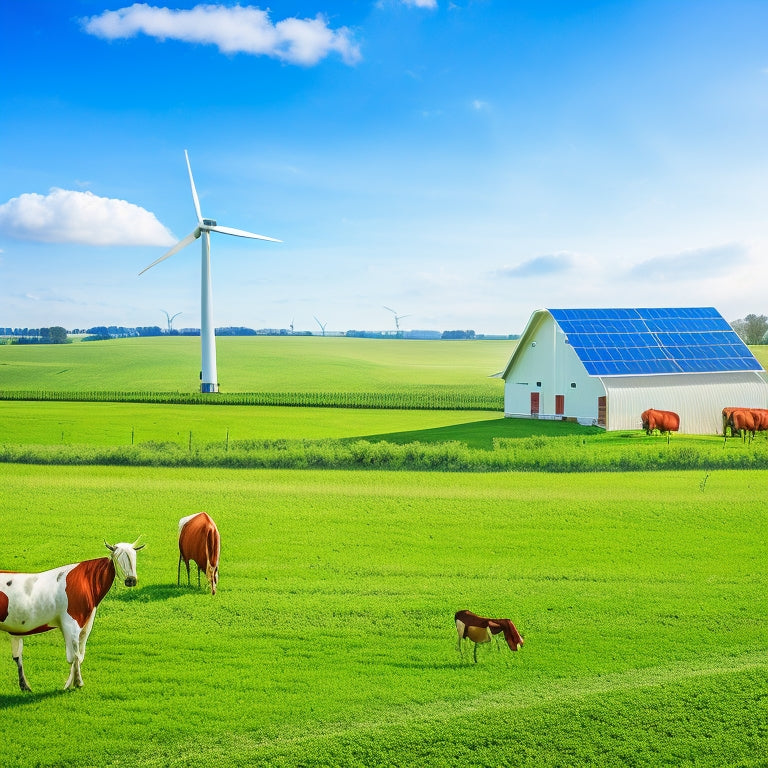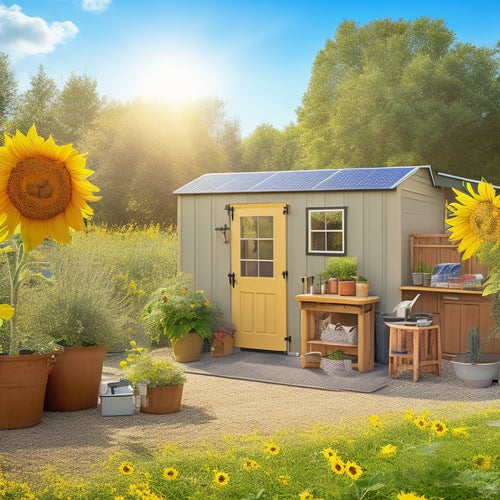
Rural Energy Independence: A Cost Guide
Share
You're likely considering rural energy independence to reduce your reliance on external power sources, and understanding the costs involved is essential for a successful shift. The average cost of solar panels ranges from $2.50 to $3.50 per watt, and system efficiency, installation methods, and energy capacity requirements influence total expenses. Battery costs, inverter types, and mounting hardware materials like aluminum and stainless steel also impact your overall investment. Factors like local building codes, zoning regulations, and available incentives can further affect your costs. As you weigh your options, consider the benefits of renewable energy - from energy independence to cost savings - and investigate the details that will help you make an informed decision.
Overview
- The average cost of solar panels ranges from $2.50 to $3.50 per watt, with system efficiency and energy yield affecting overall cost-effectiveness.
- System size and capacity requirements are crucial, and energy audits can help determine appropriate system capacity and ensure safety standards are met.
- Battery costs vary due to lithium pricing fluctuations, and energy density impacts the cost per unit of battery weight, with a typical lifespan of 10-15 years.
- Inverter costs range from $0.10 to $0.30 per watt, depending on type and quality, and understanding inverter types is crucial for efficiency.
- Local building codes, zoning regulations, and incentives must be considered, as compliance and available rebates can significantly impact overall costs and energy independence.
Understanding Solar Panel Costs
Your wallet can breathe a sigh of relief: the cost of solar panels has dropped markedly over the years, making rural energy independence more accessible than ever.
The average cost of solar panels has fallen by over 70% in the last decade, with the current price ranging from $2.50 to $3.50 per watt.
When evaluating solar panels, it's crucial to consider system efficiency and energy yield, as higher efficiency panels may lead to reduced overall system size.
You'll find that monocrystalline and polycrystalline solar panels are the most common types, with monocrystalline being more efficient but also more expensive.
Installation techniques, such as roof-mounted or ground-mounted systems, also impact the overall cost.
System Size and Installation Factors
When determining your system size, you'll need to evaluate your energy capacity requirements, which will impact the number of solar panels you need.
Your roof's size and orientation also play an essential role, as they affect how much solar energy your system can capture.
Ideal site selection is key, taking into account shading and wind direction to guarantee maximum energy production.
Additionally, you'll need to verify your system complies with local building codes, which can vary depending on your location.
System Capacity Requirements
System capacity requirements are a critical consideration in rural energy independence, as they directly impact the viability and effectiveness of off-grid energy systems. You need to determine your system load, which is the total amount of energy your home or business requires.
Energy efficiency measures can help reduce your system load, making your off-grid energy system more cost-effective. Accurate sizing considerations are essential to avoid oversizing or undersizing the kit, considering factors like load calculation, peak sun hours, panel efficiency, and autonomy days.
If you're not ready to go completely off-grid, you can consider a grid connection as a backup. Renewable sources like solar and wind power can be used to generate energy. However, you'll need to factor in maintenance costs and the impact of weather on your system's performance.
Financing options and energy audits can help you determine the best system capacity for your needs and budget.
Roof Size and Orientation
Across your roof, available space and orientation greatly impact the size and installation of your off-grid energy system.
You'll need to evaluate the roof's material, pitch, and direction to optimize solar panel placement. A south-facing roof with a pitch between 30-40 degrees is ideal for solar angle optimization.
However, even with less-than-optimal conditions, solar panels can still be effective. You'll need to factor in the roof material's impact on system performance, as some materials absorb more heat than others.
Confirm you have enough space to accommodate the required number of panels, and contemplate trimming trees or removing obstructions to maximize energy production.
Local Building Codes
Two key factors will influence your off-grid energy system's size and installation: local building codes and your energy requirements.
You'll need to comply with local zoning regulations and obtain necessary construction permits before installing your system. This involves conducting energy audits and environmental assessments to verify your system meets safety standards.
You'll also need to follow installation guidelines for building materials and inspection processes. Compliance requirements vary by location, so it's vital to research local building codes and regulations.
Working with local contractors familiar with these codes can simplify the process. Be prepared to invest time and resources in meeting these requirements, as they're significant to guaranteeing your off-grid energy system is safe, efficient, and compliant.
Rural Property Considerations
Most rural properties boast ample land, which can be both a blessing and a curse when it comes to energy independence. You'll need to take into account how you'll make use of your land to maximize energy efficiency while minimizing environmental impact.
| Property Considerations | Impact on Energy Independence |
| Land use for renewable energy systems | Can increase energy independence, but may require zoning permits |
| Access to community resources and grid access | Can reduce costs, but may require collaboration with utility companies |
| Financial planning for maintenance strategies | Can guarantee long-term energy independence, but requires careful budgeting |
| Zoning regulations and environmental impact | Can limit energy independence options, but guarantees responsible land use |
Battery Costs for Energy Storage
Several factors contribute to the overall cost of battery systems for energy storage, and understanding these factors is essential to achieving rural energy independence.
You'll need to evaluate lithium pricing, which can fluctuate, as well as the battery's lifespan, typically ranging from 10 to 15 years.
Energy density, or the amount of energy stored per unit of battery weight, also impacts cost.
Installation costs, maintenance expenses, and potential recycling options will add to the overall expense.
Additionally, government regulations and performance metrics, such as depth of discharge and round-trip efficiency, will influence your battery system's cost.
Inverters and Mounting Hardware
You'll need to evaluate the cost of inverters, which can range from $0.10 to $0.30 per watt, depending on the type and quality of the inverter.
A breakdown of these costs will help you understand where your money is going and how to optimize your system.
When it comes to mounting hardware, you'll have options such as roof-mounted, ground-mounted, and tracking systems to choose from, each with its own set of benefits and challenges.
Inverter Cost Breakdown
When sizing up the cost of an energy independence system, the inverter cost breakdown is a vital component to reflect upon.
You'll encounter different inverter types, including string, micro, and power optimizers, each with varying efficiency rates. Inverter maintenance is generally minimal, but it's important to take into account the lifespan, typically ranging from 10 to 25 years.
Features like monitoring capabilities, grid-tie functionality, and built-in grounding can impact the overall cost. Established brands like Enphase, SMA, and Fronius offer varying warranties, usually ranging from 10 to 25 years.
Inverter installation costs can add up, so it's important to include labor and materials. On average, you can expect to pay between $0.10 and $0.30 per watt, depending on the inverter's capacity and features.
Mounting Hardware Options
As you've considered the inverter cost breakdown, it's time to investigate the next vital component of your energy independence system: mounting hardware options.
You'll need to choose mounting materials that can withstand harsh weather conditions, ensuring your system's longevity. Installation techniques vary, but you should prioritize weather resistance and aesthetic options that blend with your rural environment.
Consider future upgrades and compatibility issues when selecting hardware. Maintenance requirements and cost comparisons are also significant factors.
You'll find that aluminum and stainless steel are popular mounting material choices, offering durability and corrosion resistance.
Local Incentives and Rebates
Local governments and utilities offer a variety of incentives and rebates to encourage rural residents to invest in renewable energy systems.
You can take advantage of community programs, tax incentives, and energy grants to reduce your upfront costs. Financing options, such as loans and leases, are also available through utility partnerships.
By investing in renewable resources, you'll not only gain energy independence but also contribute to environmental benefits. Attend local workshops to learn more about the incentives available in your area.
For instance, you might be able to claim a tax credit of up to 30% of your system's cost. With these incentives, you can offset your initial investment and start saving money on your energy bills sooner.
Frequently Asked Questions
Can I Install Solar Panels Myself to Save Money?
You can install solar panels yourself, but it's crucial to weigh the DIY benefits against potential risks. You'll save on labor costs, but consider your ability to handle complex electrical work and long-term solar panel maintenance responsibilities.
How Long Does It Take to Install a Rural Energy System?
You're building a puzzle, and each piece affects the bigger image. Installing a rural energy system takes around 2-5 days for a typical residential setup, depending on complexity. A well-planned installation timeline guarantees system efficiency, giving you freedom from the grid.
Do I Need to Upgrade My Electrical Panel for Solar?
You'll likely need to upgrade your electrical panel if it's outdated or can't handle your home's electrical load. Check panel compatibility with your solar system; a 200-amp panel is usually required, and you might need to replace it if it's undersized or obsolete.
Can I Use a Generator as a Backup Power Source?
"When in doubt, plug it out" - and that's exactly what you'll do with a generator as a backup power source. You'll need to take into account generator maintenance costs and fuel options like diesel, propane, or natural gas to guarantee seamless energy independence.
Will Rural Energy Independence Increase My Property Value?
You'll likely see an increase in your property value when you achieve energy independence, as it enhances your home's appeal, reduces reliance on grid power, and provides a sustainable, self-sufficient lifestyle.
Ready to Buy
You've made it to the end of this cost guide for rural energy independence. Now, you're equipped to make informed decisions about your solar panel system. Did you know that in 2020, the U.S. saw a 43% increase in rural solar adoption? This trend is expected to continue, and with the right system, you can join the movement. By considering system size, installation factors, and local incentives, you can break free from the grid and enjoy the benefits of rural energy independence.
Related Posts
-

Building an Emergency Backup Solar Power System in 5 Essential Steps
Building an emergency backup solar power system involves five key steps. First, assess your daily energy needs to ide...
-

Solar Powered Lights for Sustainable Home Decor
Solar-powered lights offer a stylish and eco-friendly way to enhance your home decor. They capture sunlight, converti...
-

Essential Hiking Lights for Safety and Fun
When you're hitting the trails, essential hiking lights are vital for safety and fun. A lightweight headlamp offers h...


